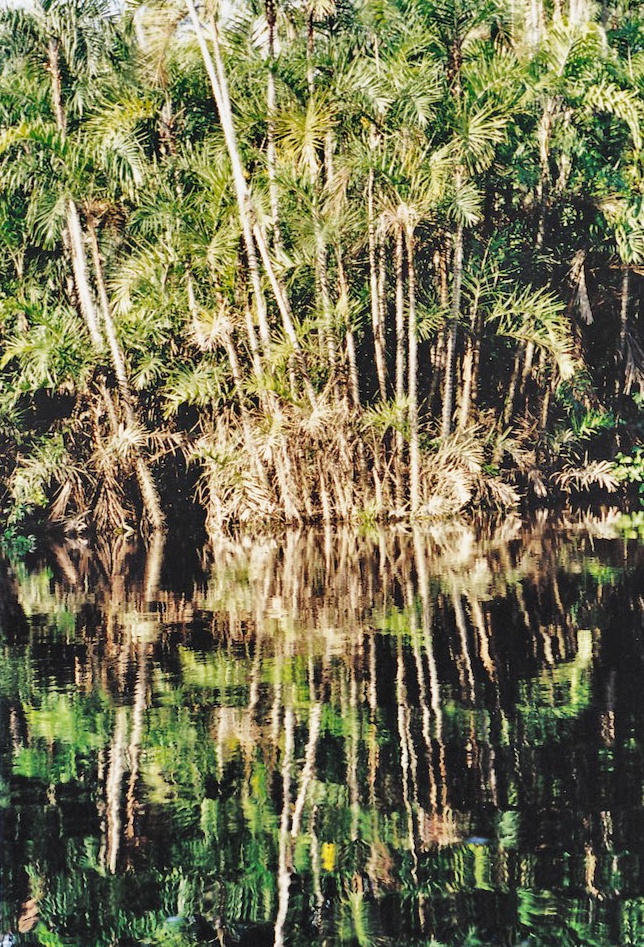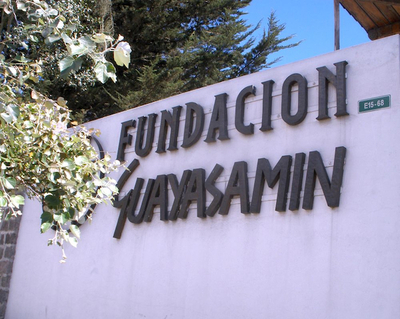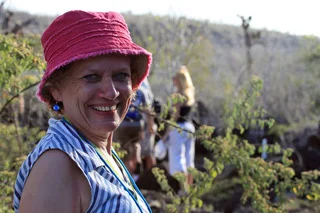When an elderly woman's stumble turns disastrous on a small-ship cruise in the Galapagos Islands, Sally Moir, a nurse on vacation, suddenly finds the traveler's life in her hands. Fortunately, all ends well, but Sally is left to wonder about the line between adventure and recklessness.
All tagged Ecuador
story and photos by Lori Marquardson
So many reasons for going to Ecuador, but being stuck on a bus full of local Evangelical Christians in a mudslide was not one of them. Sometimes you just have to go with the flow.
I had been backpacking alone through Ecuador and, deciding that a few days exploring the Amazon jungle was in order, made arrangements to meet up with a small group in the dusty oil frontier town of Lago Agrio. From there we would go to the Cuyabeno Nature Reserve for a few days of roughing it with iguanas, howler monkeys, piranhas and blue morpho butterflies.
 River reflections, Cuyabeno Nature Reserve, Ecuador.
River reflections, Cuyabeno Nature Reserve, Ecuador.
A cool drizzle fell as I boarded the overnight bus in Quito. The driver’s personal touches of green fringe and dangling images of saints above the steering wheel couldn’t mask that the bus was more contraption than road-worthy vehicle. My fellow passengers were mostly short and dark, with a number of women wearing the typical Andean dress of black bowler hats, full skirts and rubber sandals while I, the obvious foreigner on board, sported beige zip-off pants and a purple windbreaker. We headed northeast, following the twisting mountainous roads leading out of the city, and despite the jolting motion, I drifted off.
At some point, I came to: the bus was not moving, no engine running, nada. I could see the driver had relaxed into what was definitely a non-driving position: head tilted back, mouth agape, arms crossed over his chest, and legs spread-eagled. Strange, but having been in South America for quite some time, I had experienced unexplained delays before and generally they weren’t show-stoppers, so I tried to fall back asleep. Then came a huge rumble outside, followed immediately by murmuring voices inside.
“What the hell is that?” I said to no one in particular and, being in the front row, I leaned over to the driver, and asked “¿Qué está pasando? “
“Hay un derrumbe.” A landslide. Hmmm, that did not sound good.
What If We Didn't Go Home?
“So, when exactly are you coming home?” my father asked.
“I don’t know, Dad. Our visas allow us to stay in Peru for at least three months, then we’re thinking of heading on to Argentina and Chile...”
The broken and sputtering magicJack connection at the South American Explorers Club in Cusco broadcasted about every third word of our conversation, but the message that traveled down the steep stone streets of the ancient Inca capital and across the continents to the lush green lawns of Newark, Delaware, the college town I’d grown up in and where my parents still live, was crystal clear: We weren’t coming “home”.
The truth was, my husband, Hank, and I had no idea when, or if, we were going home. We didn’t even know what “home” meant anymore. We’d been winging it, temporarily inhabiting Mexico, Nicaragua, Ecuador, and Peru: itinerant and loose in the world in a manner that both worried and intrigued family and friends back home.
We were four thousand miles from our homeland, eleven thousand feet above sea level, south of the Equator where summer is winter, and living in a fourth-floor walkup without heat. Yet, life felt sweet and rich and fortunate.
It started out with a scant breakfast (have you ever tried a one egg omelet?) and miles of walking around the city streets of Quito in Ecuador wearing wedged sandals instead of sneakers. Wedged sandals are not the shoes of choice when traveling. My feet, already aching, were really in a state of extreme protest, a not too subtle indication of the agony to come. We were on our way to visit the art exhibit we’d been anticipating all day, but hadn’t quite left any time out for either lunch or water.
 The Guayasamin Museum was our destination and surpassed all our expectations. The paintings and sculpture were impressive and the house in which they were displayed, splendidly representative of the Ecuadorian painter’s era (1919-1999). The original house had an extensive collection of pre-Columbian art he had acquired over decades. The only downside was that there was no place to eat! Our dilemma was if we were to start searching for a restaurant, there wouldn’t be time to get to Guayasamin’s Capilla del Hombre (The Chapel of Man), which was a “must.” By now it was a toss-up as to which was worse, my overwhelming hunger or my throbbing feet.
The Guayasamin Museum was our destination and surpassed all our expectations. The paintings and sculpture were impressive and the house in which they were displayed, splendidly representative of the Ecuadorian painter’s era (1919-1999). The original house had an extensive collection of pre-Columbian art he had acquired over decades. The only downside was that there was no place to eat! Our dilemma was if we were to start searching for a restaurant, there wouldn’t be time to get to Guayasamin’s Capilla del Hombre (The Chapel of Man), which was a “must.” By now it was a toss-up as to which was worse, my overwhelming hunger or my throbbing feet.
We decided to skip the restaurant search and walk to the Capilla which, we were assured, was just a short distance away. We simply couldn’t take a chance on missing the experience of visiting this most amazing structure, Oswaldo Guayasamin’s final dream, completed three years after his death as a tribute to the 500-year struggle of indigenous people of the continent.

